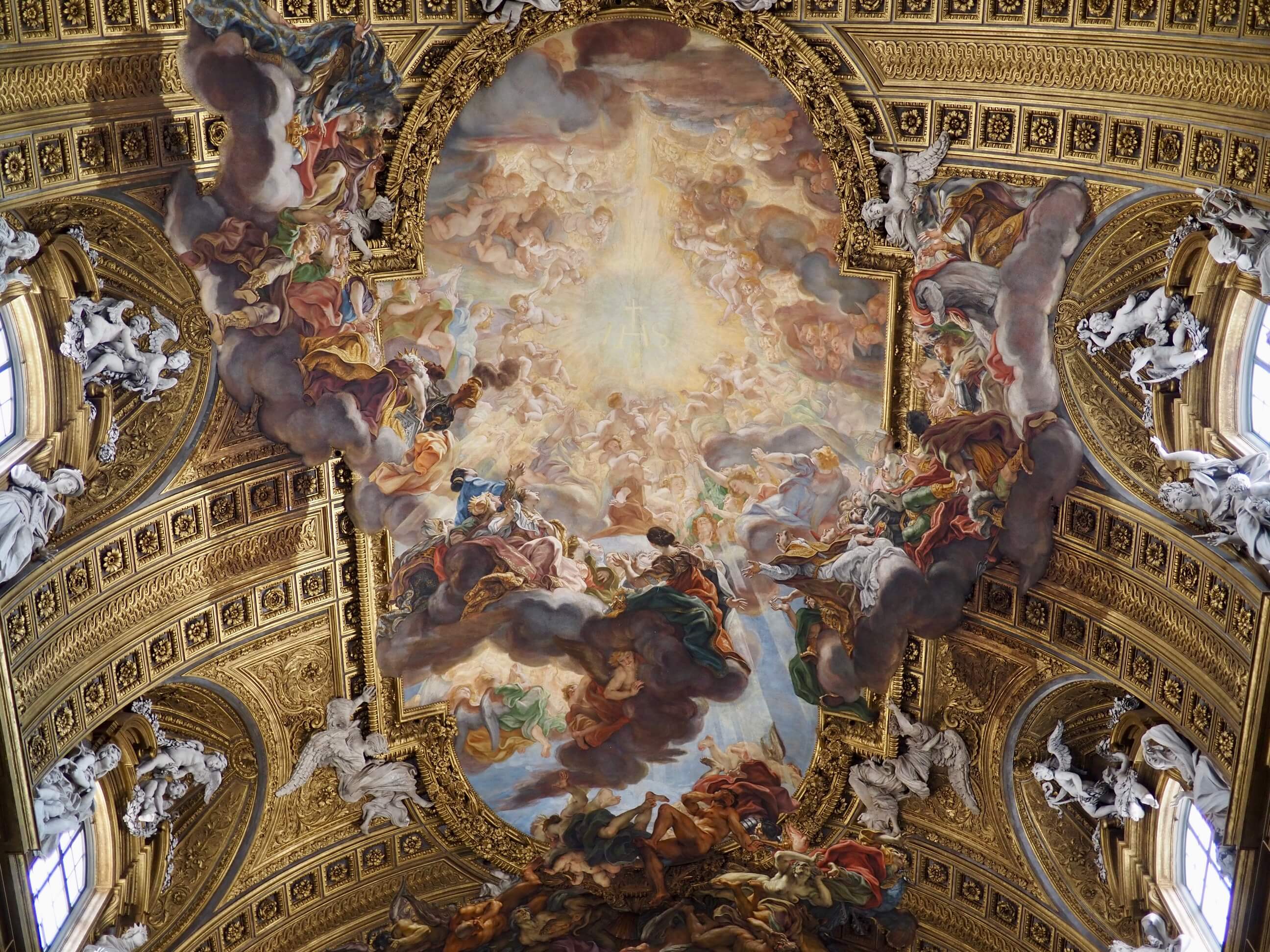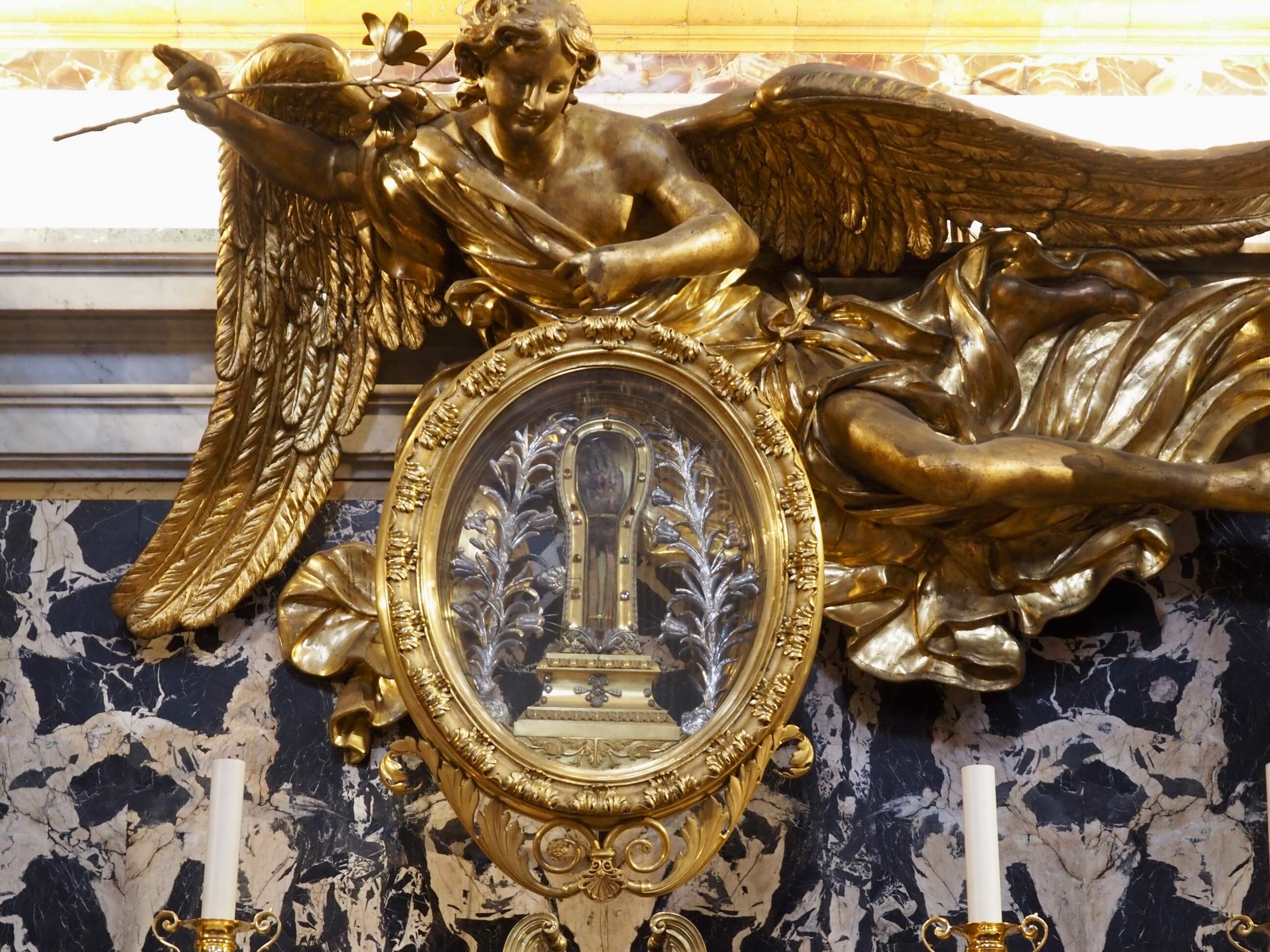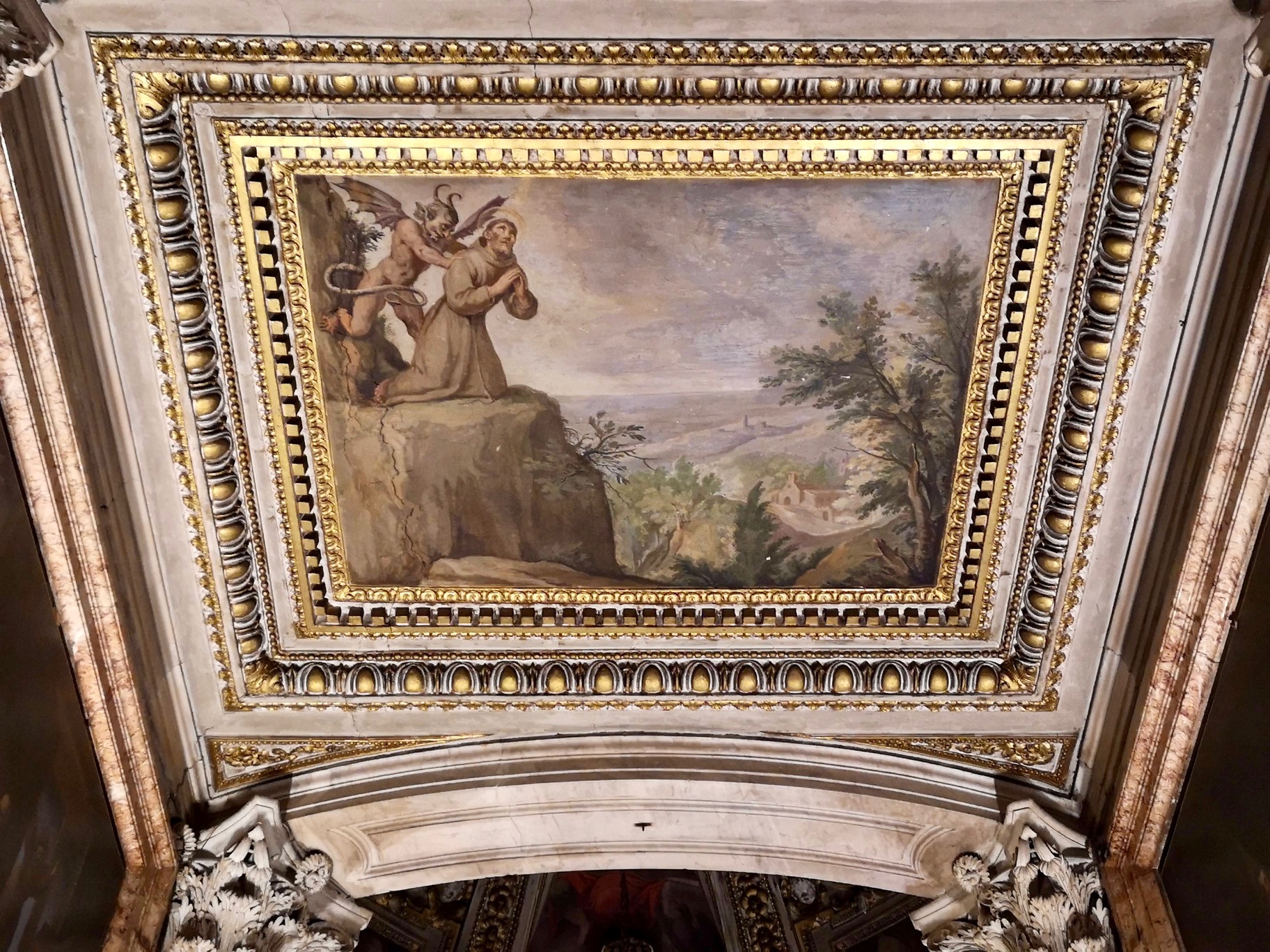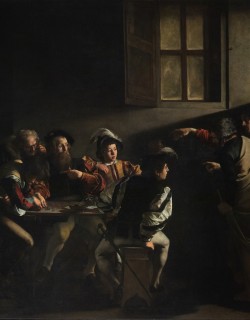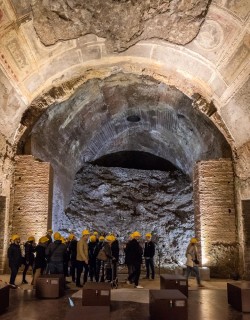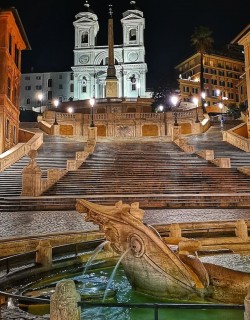There are countless Baroque churches in Rome; but the Gesù takes things to the next level. Built as the headquarters of the powerful new Society of Jesus in 1558 with funds provided by their immensely wealthy and powerful backer Alessandro Farnese, it’s the beating heart of the Jesuit order and a crucial landmark of the Catholic Counter-Reformation. A series of daring decorative campaigns over the following century set the tone for a bold new vision of religious architecture: emotionally powerful, visually dazzling, and deeply theatrical.
Founded by Ignatius of Loyola, the Jesuits combined rigorous spiritual discipline with a flair for spectacle; nowhere is that more evident than in the Gesù’s breathtaking chapels, relics, and ceiling frescoes. From Baciccio’s ceiling that erupts into heaven to Andrea Pozzo’s opulent Chapel of Saint Ignatius - complete with Baroque trickery - every inch of the Gesù is designed to move the heart, mind, and soul. If you want to understand what Baroque Rome is all about, then you need to pay a visit.
Here’s what you need to see at the Gesù in Rome.
The Ceiling Fresco
In the wake of the Counter-Reformation’s call to arms for a renewed focus on the power of art to amaze the faithful with incredible feats of painterly virtuosity, Roman artists outdid themselves in their quest to stretch the limits of their talents in the many grand new churches that were springing up all across the city. As the mother church of the recently founded Jesuit order, the Gesù was amongst the most opulent of them all. The grandiose church’s interior is an aladdin’s cave of precious art - but it’s the extraordinary fresco covering the entire length of the ceiling and the cupola that really takes the breath away.
The artist, known as Il Baccicio, has seemingly conjured up a miracle wholly appropriate to the sacred surroundings. As you cast your gaze upwards, the church’s vault seems to disappear in a swirling mass of clouds, opening up a direct view into the celestial sphere of heaven itself. The subject matter was one dear to the Jesuits - the Triumph of the Name of Jesus.
Bathed in blinding rays of celestial light, the monogram of Christ’s name hovers at the ceiling’s centre surrounded by an array of angels and holy figures rapt by the miracle. Rebel angels beguiled by Satan’s empty promises of power tumble illusionistically from the vault in a tangle of grotesque limbs and tortured poses, defeated by the mere mention of Christ’s name.
The free combination of painting, sculpture and architecture combine to create a theatrical, multi-sensorial and three-dimensional ensemble that's Baroque bombast at its very best.
The Rooms of Saint Ignatius
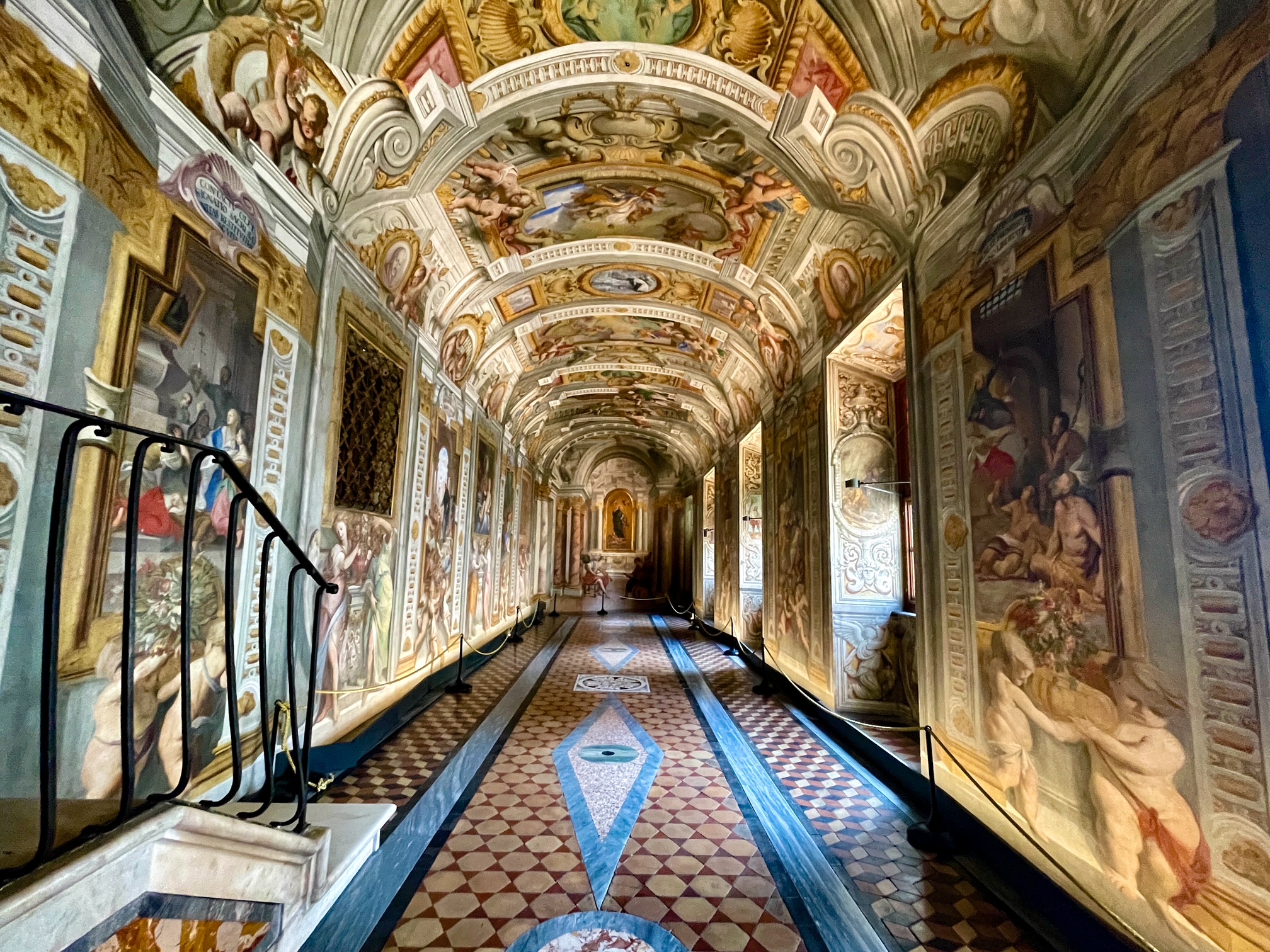
Step through an ordinary door beside the Gesù and find yourself transported into another world. These are the Rooms of Saint Ignatius: the simple chambers once inhabited by the founder of the Jesuits, reverentially preserved when the convent was rebuilt in the late 1600s.
But don’t expect monastic austerity. In the hands of painter, monk, mathematician and all-round genius Andrea Pozzo, these modest rooms became a dazzling showcase of Baroque illusionism. Over a century after the saint’s death, Pozzo transformed the corridor leading to Ignatius’ humble living quarters into a painted gallery of illusionistic arches, niches, beams, and cornices framing scenes from Ignatius’ life.
The perspective shifts with every step, culminating in a an amazing anamorphic chapel at the end, where angels seem to play music inside a space that isn’t really there. A marble rose on the floor marks the one spot where everything snaps into perfect perspective.
The rooms are totally free to visit, and open between 4 and 6 PM each day. Thousands of tourists rush past the unassuming entrance each day, little imagining the riches hidden inside. Don’t make their mistake!
The Chapel of Saint Ignatius

If the Gesù is the architectural manifesto of the Jesuit order, then the Chapel of Saint Ignatius is its beating heart - a theatrical explosion of triumphalism dedicated to the society’s indomitable founder. Occupying the left transept, the chapel was completely reimagined at the end of the 17th century by Jesuit brother Andrea Pozzo, whose vision marshaled over a hundred artists and craftsmen into one of the most dazzling Baroque ensembles in Rome.
Massive in scope, it overwhelms at first sight: colossal bronze columns inlaid with priceless lapis lazuli imported from distant Afghanistan; gilded putti and reliefs gleaming in every niche; angels hoisting the Jesuit monogram IHS high above the altar. At the center is an enormous altarpiece depicting Ignatius being welcomed into heaven. Bronze reliefs set into the plinth meanwhile tell stories from Ignatius’s life - miraculous healings, dramatic conversions and the like.
Below rests the saint himself: or rather, his relics, contained within a 1637 bronze urn by Alessandro Algardi, the only surviving element of the earlier 17th-century design.
The Baroque Machine
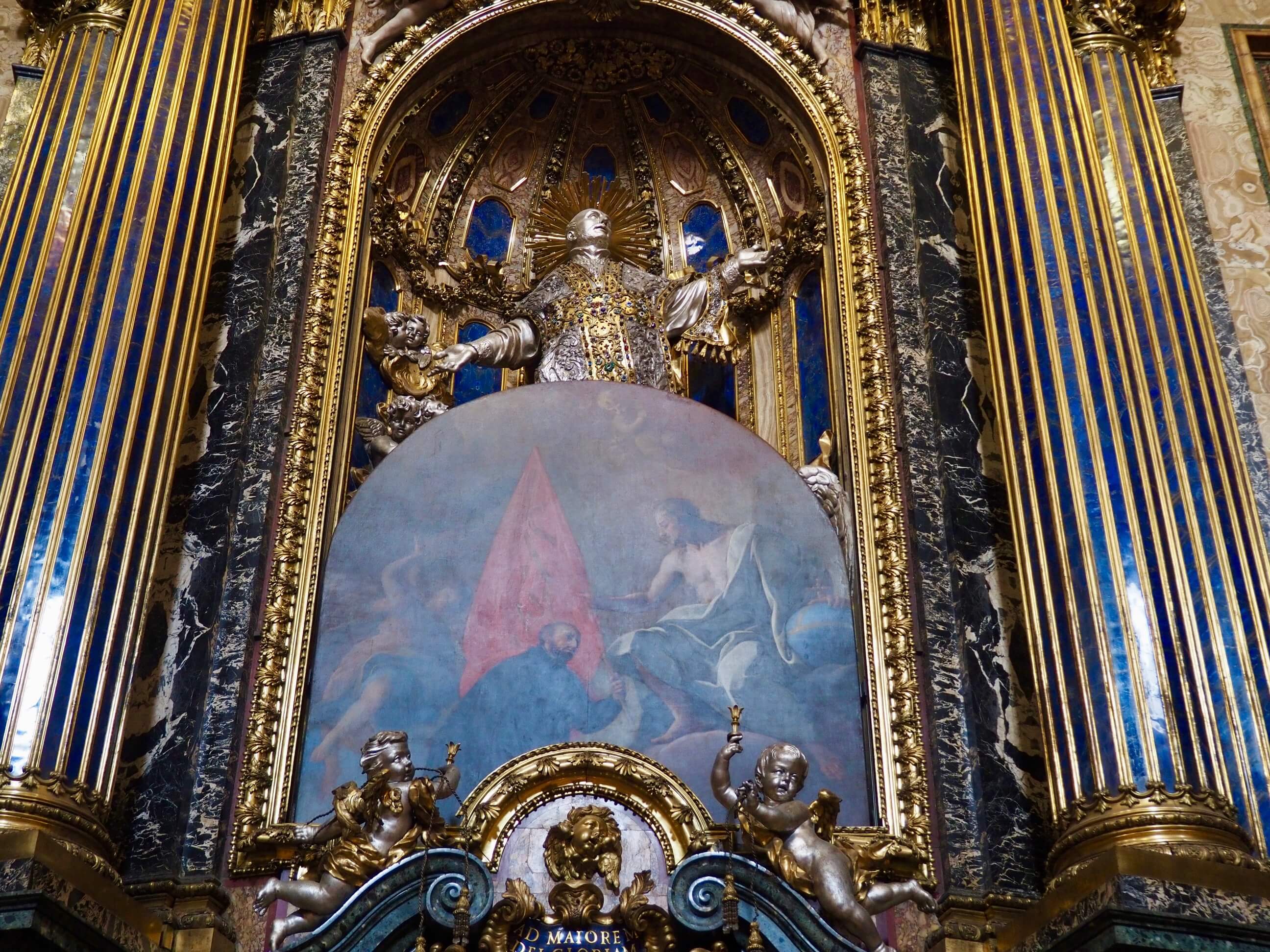
There’s more to the chapel of Ignatius than meets the eye. Every evening at 17:30, one of Rome’s most astonishing spectacles unfolds here. As music fills the air, the large altarpiece above Saint Ignatius’s tomb begins to descend, sliding downwards on invisible tracks to reveal a glittering hidden statue of the saint in an illuminated niche behind. This dramatic unveiling, orchestrated by an 18th-century macchina barocca (Baroque machine), captures the full theatrical spirit of the Counter-Reformation, when processions, pyrotechnics, and automata were all part and parcel of Catholic theatrical devotion.
The machine dates from the end of the 17th century and was an integral part of Pozzo’s original design for the chapel. The original sculpture was a magnificent silver and gilt-copper affair by renowned artist Pierre Le Gros, tragically melted down in 1798 amidst the chaos following Napoleon’s invasion of Rome. A replacement was made, but over time the baroque machinery fell into disuse; a 2006 restoration returned the machine to its original glory, and it now stands once again as an incredible testament to the Jesuits’ unmatched flair for religious drama.
The Dome
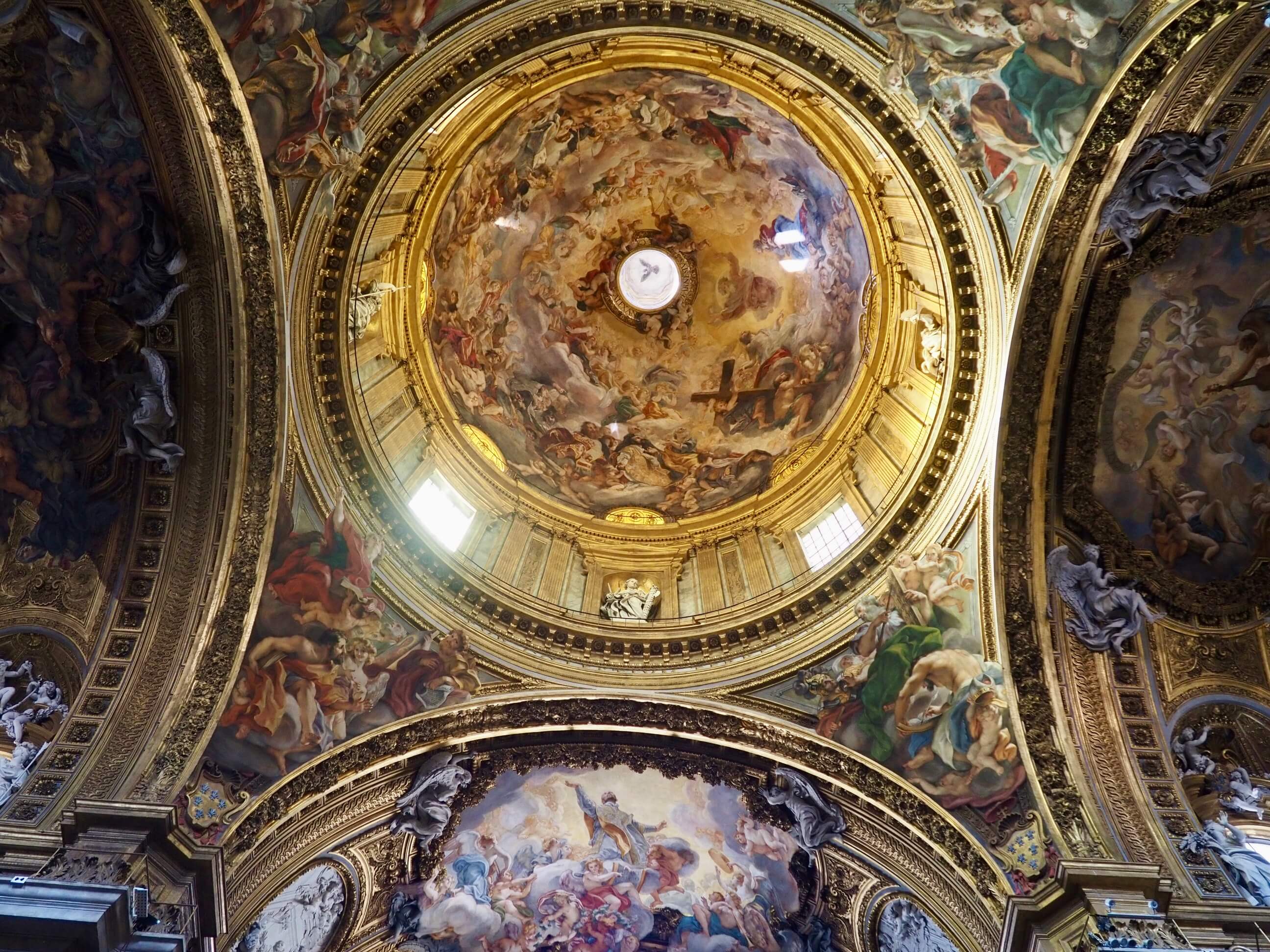
Look up: the dome of the Gesù opens not just skyward, but heavenward. Designed by Giacomo della Porta, it rises over the crossing like a celestial vault, crowned by one of the most glorious frescoes in Rome. Bacicio was again responsible for painting the dome’s radiant Glory of Paradise fresco, filling the space with a swirling vision of angels, saints, and divine light that draws the eye - and soul - upward.
Known as an empyrean, this motley crew of holies is a real who’s who of heaven: evangelists, prophets, martyrs and doctors of the Church rub shoulders amidst the clouds. At the focal point of the fresco God the Father makes an appearance flanked by Christ and the Virgin Mary, while Jesuit saints - Ignatius Loyola, Francis Xavier, Aloysius Gonzaga and Stanislaus Kostka - bring the heavenly group right up to date.
At the dome’s summit, a lantern symbolizes the dwelling place of God above the heavens, with the Holy Spirit depicted as a radiant dove pouring down grace on all below.
In true Baroque fashion, architecture and painting fuse into a single spiritual experience. The dome dissolves its physical boundaries to immerse the viewer in the glory of the divine: paradise has never seemed so close.
The Arm Relic of Saint Francis Xavier
To the right of the main altar lies one of the Gesù’s most remarkable - and strangest - treasures: the right arm of Saint Francis Xavier, one of the founding members of the Jesuit order. Whilst Ignatius stayed in Rome to manage the society, Xavier embarked on a series of dangerous missionary missions to Asia, where he is said to have baptised thousands of converts across the continent with the very appendage preserved here in a sumptuous bronze reliquary.
Xavier’s epic journey across the east, from India to Japan and the shores of China, is one of the defining events of Jesuit history. After his death there in 1552, Francis’ apparently incorrupt body was eventually interred in Goa, at that time a Portuguese colony. After calls for his body’s repatriation to Rome grew, his right arm was transferred to Rome in 1614 - minus a big toe that was apparently bitten off by an overzealous worshipper seeking a bodily relic of the soon-to-be-saint.
The chapel itself, designed by Pietro da Cortona and completed in the 1670s, radiates theatrical Baroque splendor - all fluted marble columns, gilded capitals and dramatic frescoes, including one in which Xavier retrieves a crucifix from a crab on a Malaccan beach - but it’s the relic at its heart that gives this space its true emotional charge.
The Madonna della Strada
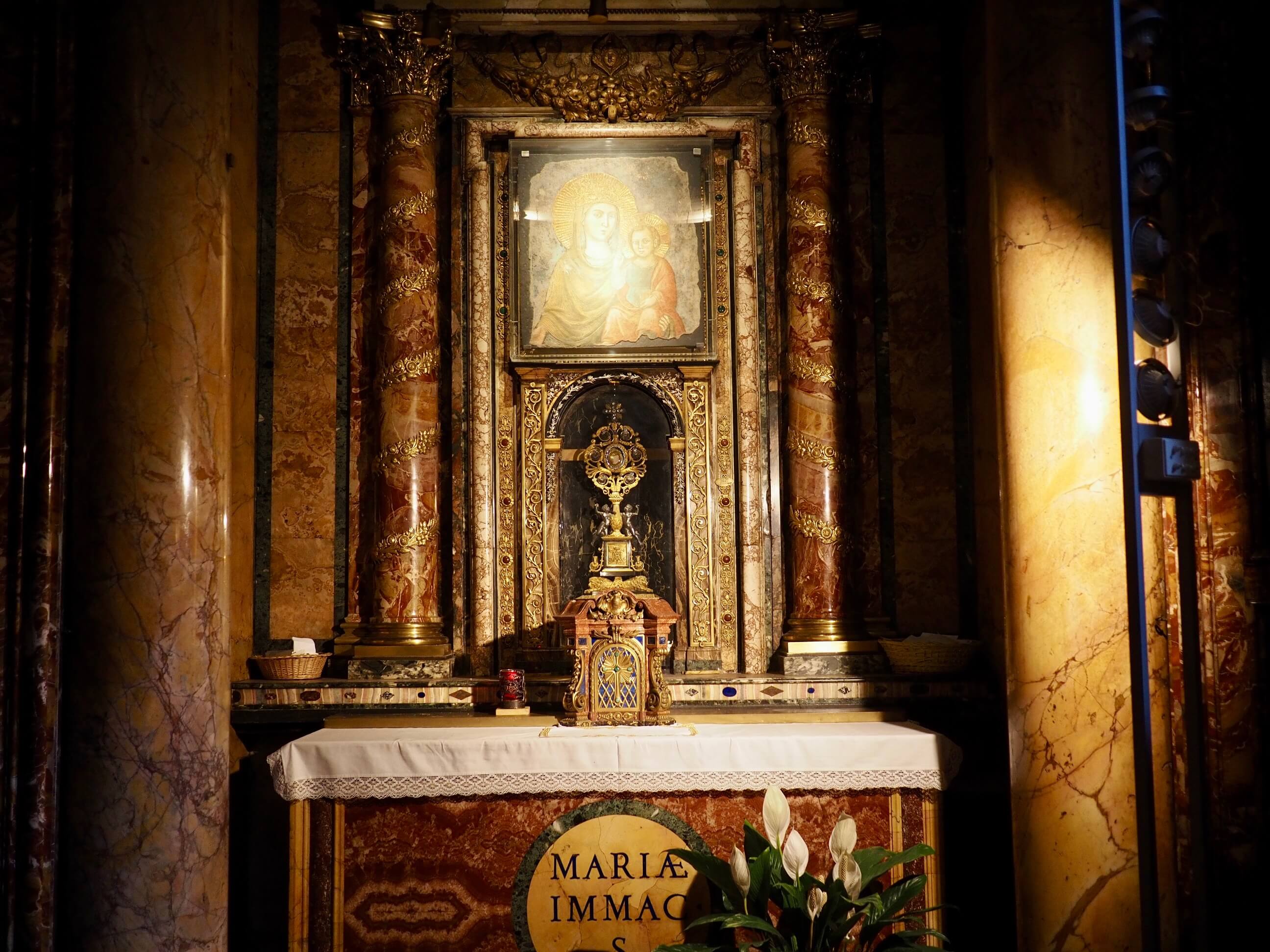
To the left of the sanctuary, this small and tenebrous chapel enshrines one of the most important devotional images in Jesuit history: the Madonna della Strada, or “Our Lady of the Road.” The fresco comes from the small medieval church of Santa Maria della Strada that once stood on this site, demolished in the 16th century to make way for the Gesù.
Before construction began, the image was carefully transferred to the church of San Marco in order to preserve it from destruction, and later reverentially installed here in a formal ceremony. Ignatius and Francis Xavier were particularly fond of the Marian image, before which they regularly prayed, earning her the nickname ‘The Queen of the Jesuits.’
The chapel itself is richly decorated. Andrea Pozzo painted angels across the small dome, and seven scenes from the life of the Virgin by Giuseppe Valeriano line the walls, each accompanied by scriptural inscriptions in marble.
Religion Overthrowing Heresy and Hatred – Pierre Le Gros (1700)
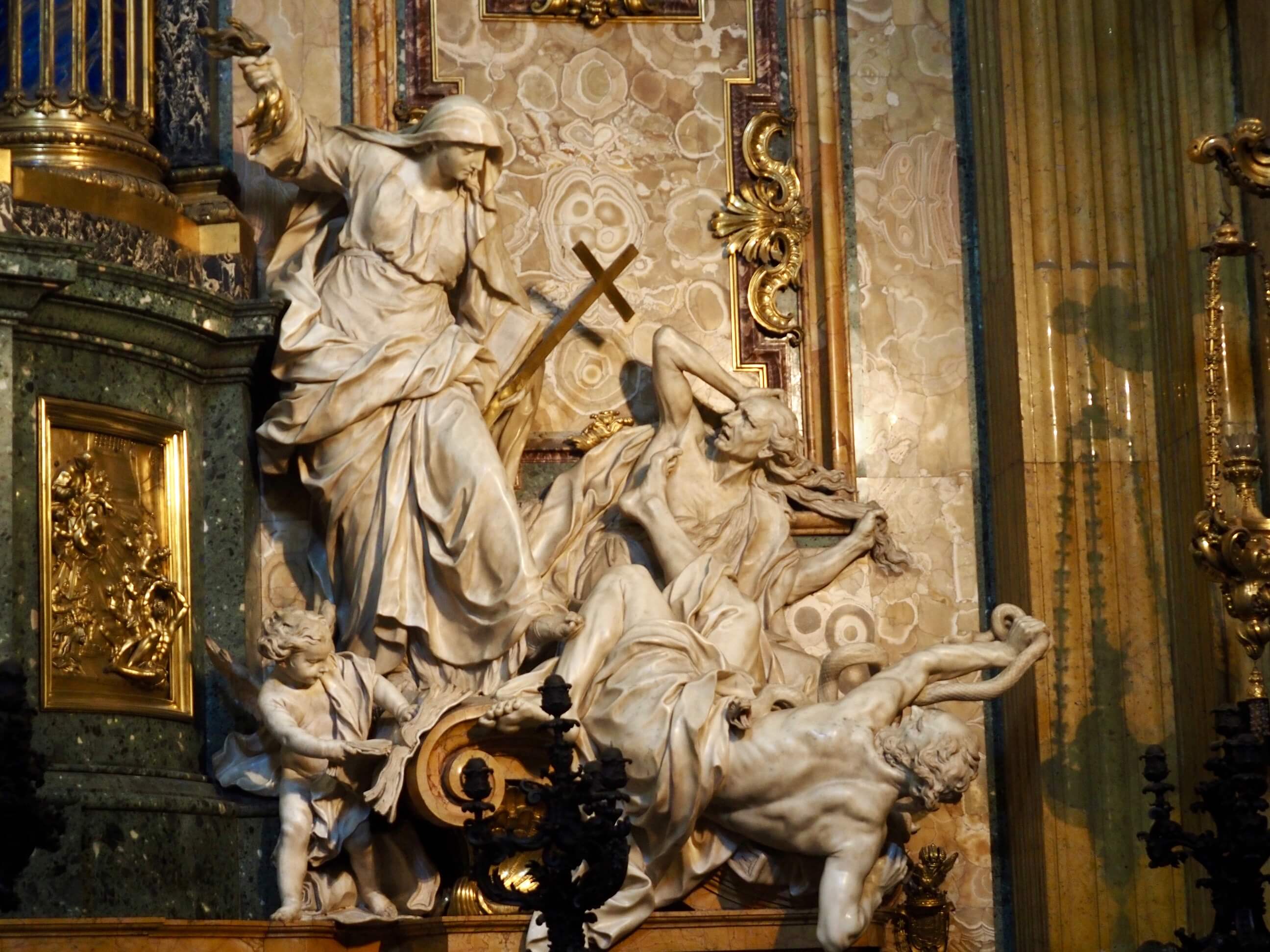
After you’ve taken in the grandeur of the Ignatius Chapel, look closer - because the real drama is in the details. In a flurry of marble drapery, outstretched limbs, and righteous rage, Pierre Le Gros’s Religion Overthrowing Heresy and Hatred stages one of the most visceral allegories of the Baroque at the right edge of the altar.
Commissioned as part of the wider decorative scheme by Pozzo, the sculpture pits the Church Triumphant—personified as a serene yet unyielding female figure—against the forces of Protestantism. Religion, standing tall and resolute, hurls thunderbolts down with divine fury. At her feet, a wild-eyed woman—Hatred—claws backward in agony, while Heresy, a bearded male figure twisting in torment, writhes beneath the saint’s triumph. Look closer and the ideological stakes sharpen: a putto gleefully rips pages from a book by the Swiss reformer Zwingli, while another volume lies discarded below with “Luther” blazoned on its spine.
This is Catholic victory carved in stone - pious, polemical, militant and impossible to ignore.
Though Pozzo conceived the overall program, Le Gros clearly ran with the visual freedom, channeling all the fire and fury of the Counter-Reformation into cold, gleaming marble. In a chapel built to glorify the Jesuits’ founder, no message could be clearer: heresy will not stand, and the true faith - like Ignatius - rises victorious.
The Chapel of the Sacred Heart
In the right transept of the Church of the Gesù is a small, circular chapel that holds a quiet surprise: a richly painted cycle of scenes from the life of Saint Francis of Assisi. Why such a prominent homage to the poverello from Umbria in the Jesuit mother church? The answer is simple - Francis’ radical commitment to poverty and spiritual fire deeply inspired Ignatius of Loyola himself.
The frescoes that line the chapel form a kind of pictorial vita that link Francis’ life to that of Ignatius - renouncing wealth, communing with nature and seeing God’s hand in all things, preaching before the sultan - each of these images offers a visual theology of humility, obedience, and evangelical zeal - the very values that shaped the early Jesuit mission.
MORE GREAT CONTENT FROM THE BLOG:
- A Guide to the Jubilee of 2025 in Rome
- Top Things to See in Santa Maria Maggiore
- The Wonders of San Giovanni in Laterano
- The Best Things to Do in Rome this Summer
- The Best Free Museums in Rome
- The Best Palaces in Rome
- 10 Popes Who Shaped Rome
- What to See in the Vatican Museums


